This page contains affiliate links. Please read our disclosure for more info.
Deciding what to pack for Norway in winter can be daunting, especially if, like us, you’ve never been so far north (Tromso is 350km above the Arctic Circle).
As always with packing, the answer is layers that you can adapt to different conditions. We mostly managed with clothes we already owned, although we did invest in a new warm jacket and a few extra accessories.
In this post, I share what to wear in Norway in winter (including our clothes for various activities) and our packing list for Tromso.
Contents
- Our Norway Trip
- What to Wear in Norway in Winter
- What We Wore in Tromso in Winter
- Our Norway Winter Packing List
- More Norway Tips
Our Norway Trip
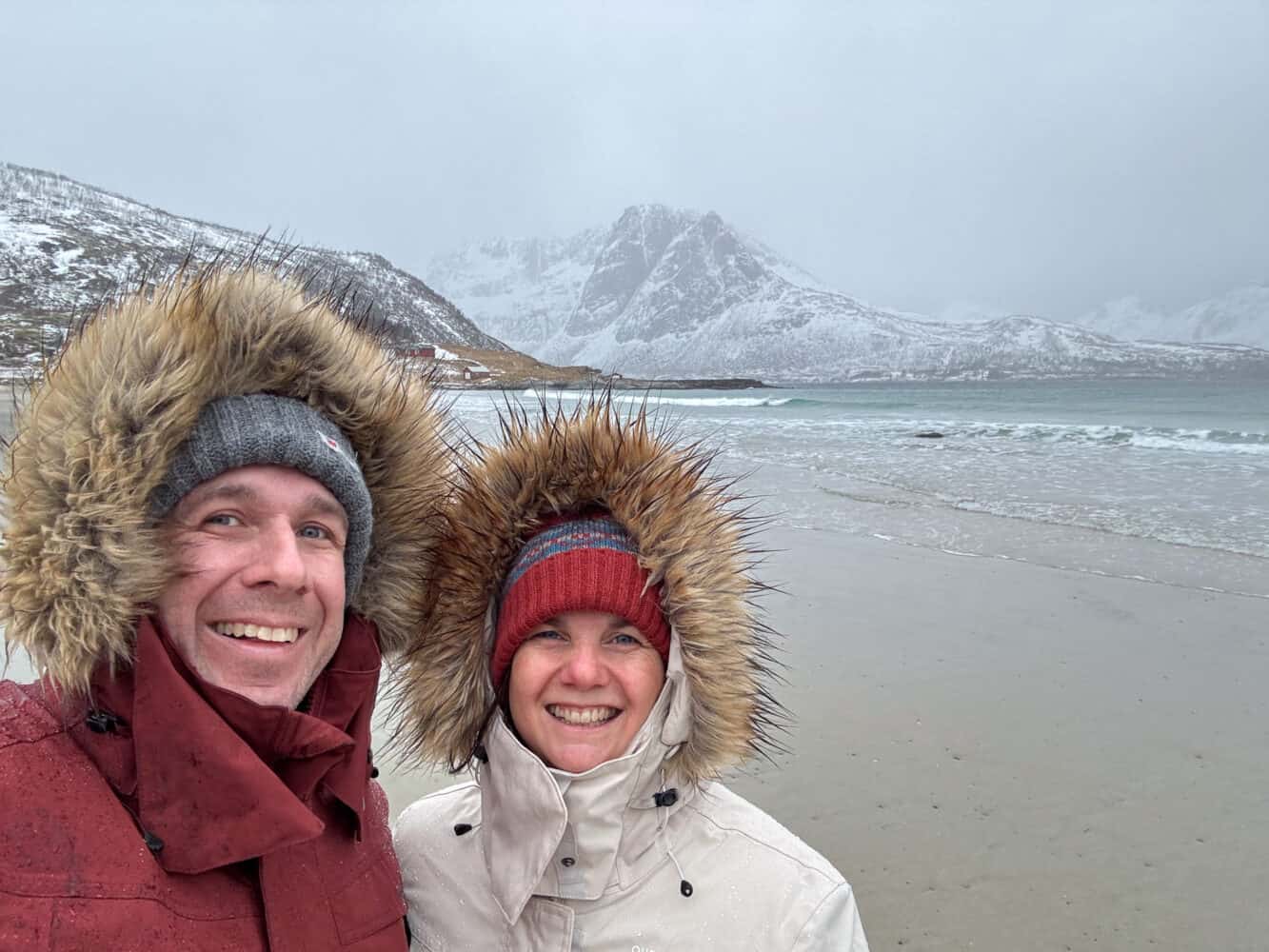
Our trip was at the beginning of February for nine nights—seven nights in Kvaloya and Tromso in Northern Norway and two nights in Stockholm, Sweden (to see family).
Tromso has a surprisingly mild climate for the Arctic due to its location by the sea. Yes, it’s cold, but it’s not crazy cold.
The average low in January and February is -5ºC (23ºF) and the average high is -1ºC (30ºF). December and March are only a degree warmer.
At the start of our trip, it was -5ºC and snowy, but then we had some unusually warm and rainy days at 6ºC (43ºF). In both cases, the wind chill factor made it feel significantly colder.
If you are travelling inland in Northern Norway, it can be much colder (-20ºC/ -4ºF or lower). We didn’t wear all our layers, so we could have coped with lower temperatures with the gear we had.
See my guide to the best things to do in Tromso in winter for everything we did.
What to Wear in Norway in Winter
Base Layers
Base layers are key to any packing list for Norway in winter. You’ll want thermal bottoms (long johns) and tops (long-sleeved T-shirts) that fit close to your skin and can be layered under your other clothes.
Norwegians swear by wool as a base layer and for good reason.
It’s warm but temperature-regulating, so you don’t get too hot or too cold. It wicks moisture from your skin if you get sweaty (which you will being active in all these layers).
Wool is also odour-resistant, so you can wear it multiple times without it smelling.
Ideally, pack two sets of base layers that you alternate (with a few extra tops), but you could manage with one pair of bottoms.
We love merino wool, which is soft and not itchy. We both have Icebreaker tops—the Oasis 200 Crewe is an ideal base layer (available on Amazon or REI). It’s expensive but lasts for years.
We supplemented our Icebreakers with more affordable base layers from Uniqlo (look at their Heattech range, especially if you don’t like wool) and Mountain Warehouse in the UK (their 70% merino items are more affordable).
I wore my Icebreakers for the most active and cold activities, and the non-merino base layers for evenings and casual outings.
Mid Layers
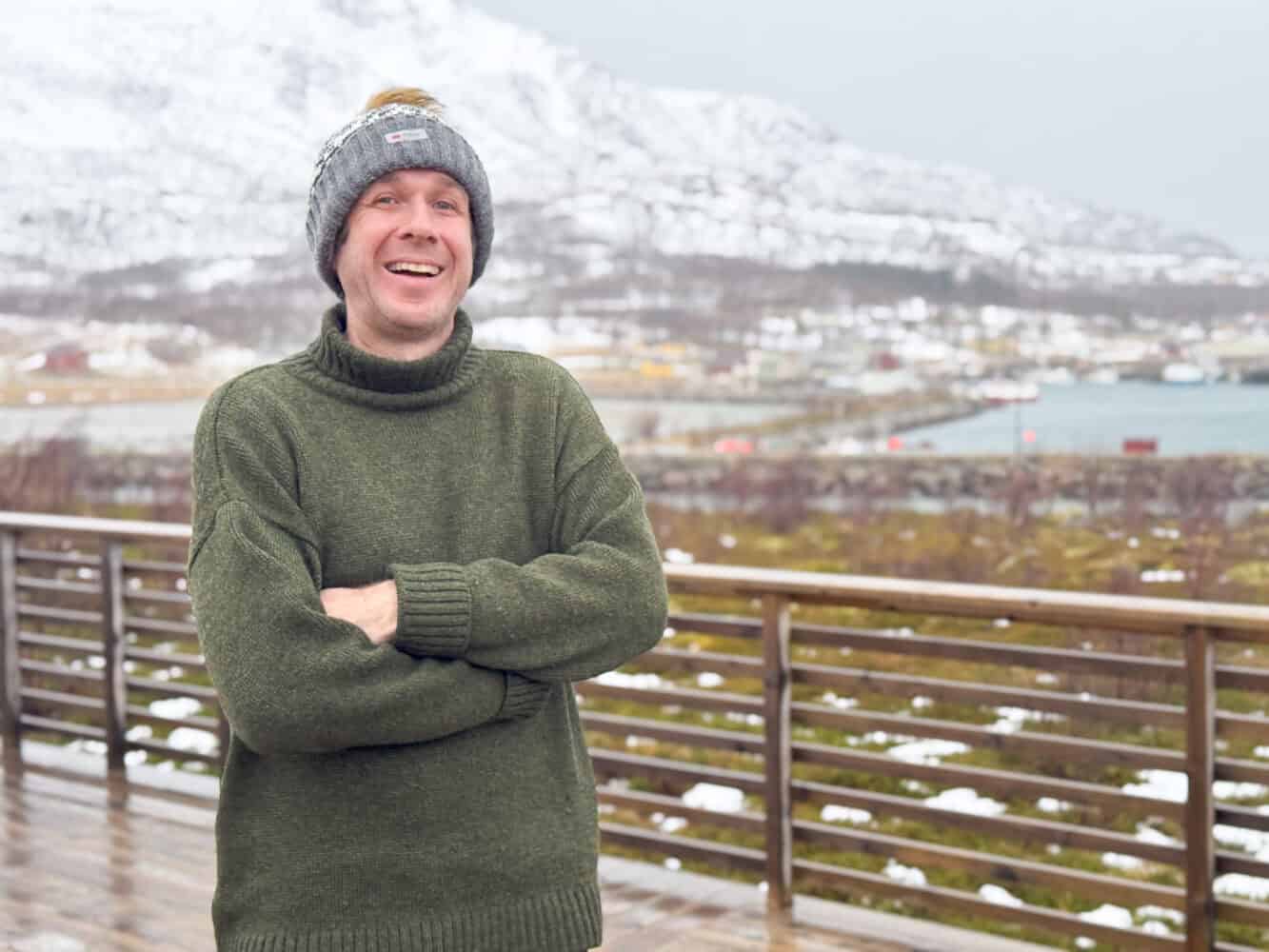
On top of your base layer, you’ll need one or two warm layers to wear under your jacket.
Again, the Norwegians love wool for all its excellent properties. We both wore 100% wool jumpers as our mid layer and alternated between two. They worked for active adventures and dinners out (Norway is casual).
You could choose fleece instead of wool.
I also brought a lightweight cashmere jumper that I planned to wear under my thicker wool jumper as an extra layer, and a Uniqlo Fluffy Fleece that I could wear on top of that.
I didn’t need the extra layers most of the time.
Bottoms
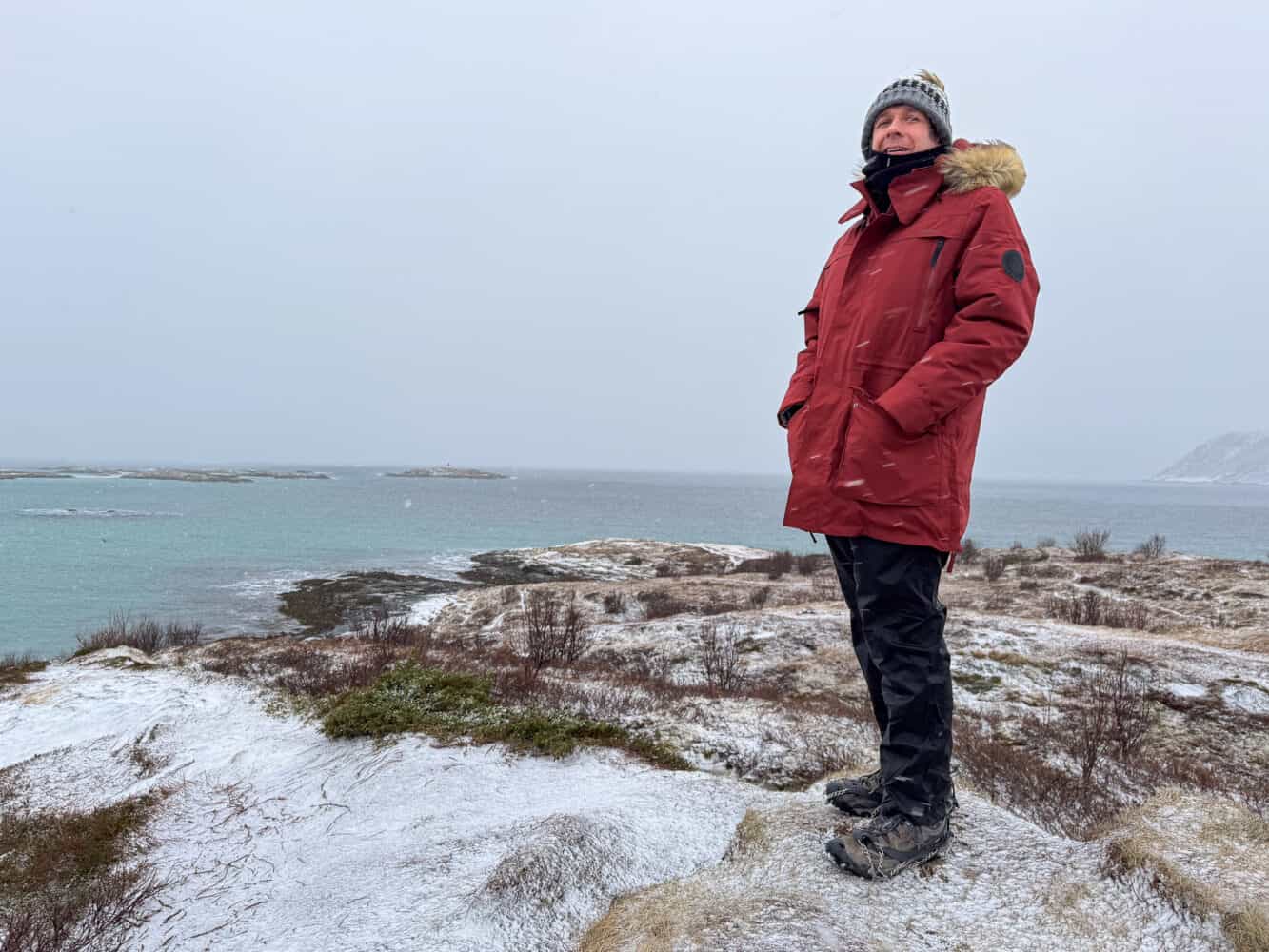
I wore my fleece-lined, water-resistant winter hiking trousers from Acai for most activities during the day and jeans for going out to dinner or walking around town.
Simon wore his Bluffworks chinos for active things and jeans the rest of the time.
As his trousers weren’t waterproof, he wore thin waterproof trousers (similar to these REI Rain Pants) over them.
I think packing water-resistant hiking trousers is more convenient, but he didn’t want to buy a new pair (and he loves all the pockets in the Bluffworks chinos). The overtrouser is a cheaper solution.
Jacket
We only owned lightweight jackets, so we bought a new parka for our Norway trip.
If you already have a knee-length winter jacket, that will probably work.
We were happy our jacket was waterproof, though, as we had a lot of snow and rain.
We both bought the Decathlon Waterproof Hiking Parka -20°c and were happy with its ability to keep out the cold, wind, and rain.
It has plenty of pockets big enough for bulky gloves and a couple of zipped chest pockets (inner and outer) for our phones.
Accessories
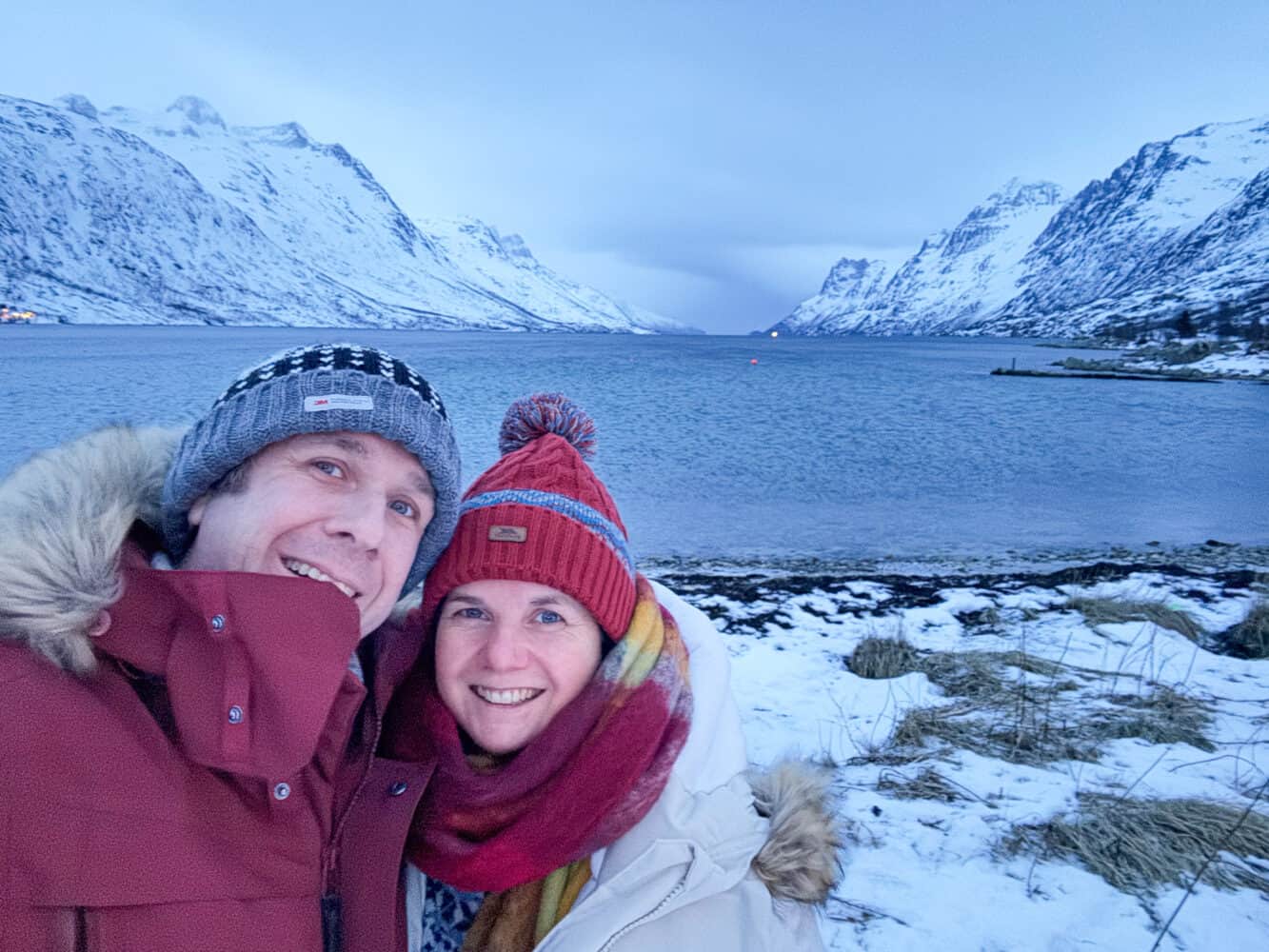
Accessories are essential. You’ll need a warm hat, preferably fleece-lined to keep out wind.
A scarf that can cover your face is important, too. I brought a large scarf but found my fleece neck warmer (tube-shaped) more practical, as it was small enough to fit in my pocket when not needed.
We both had a few pairs of gloves. A thinner pair that works with your phone is important for taking photos or checking directions.
Simon has merino wool gloves and I bought silk liner gloves from Decathlon that I could wear under my other gloves.
We both had thick, waterproof ski gloves. These were useful for activities like dog sledding, skiing, and feeding reindeer, but they were overkill for around town.
Often Simon just wore his merino gloves and I had another pair of thick fleece-lined knit gloves.
Boots
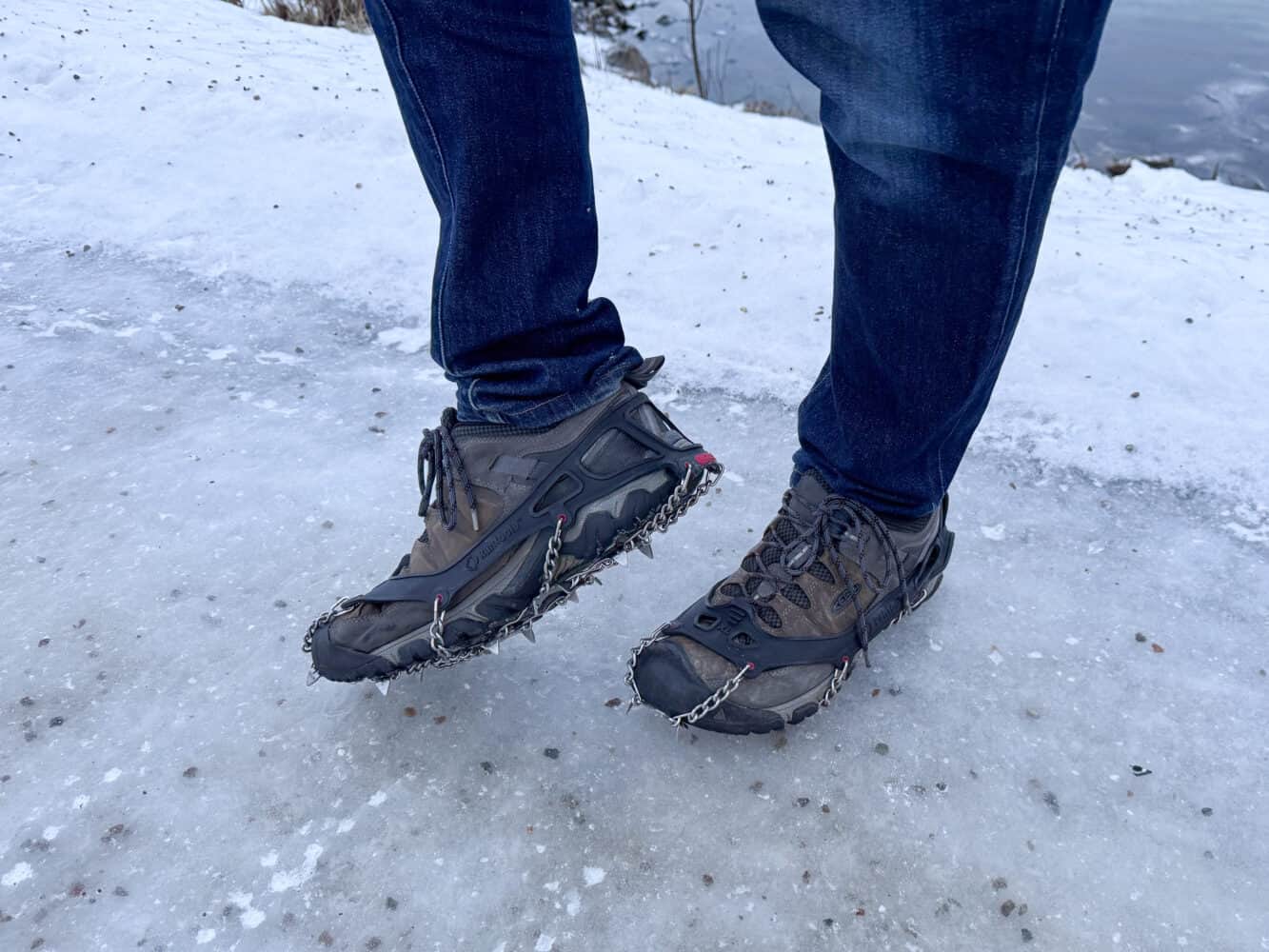
Most people recommend snow boots for Norway, something waterproof with an insulated lining to keep your feet warm, such as Sorel Winter Boots.
We didn’t want to buy an extra pair of boots, so we used what we had, and it worked fine.
If you already have a pair of waterproof hiking boots, I would bring them, even if they are not insulated, as long as you can fit thick socks underneath. Hiking shoes can also work.
Some activities like self-drive dog sledding and cross-country skiing provide boots anyway.
The most important feature of your footwear is a grippy tread. Pavements, car parks, and roads in Norway are icy in winter, and it can feel like walking on an ice rink.
We found the most dangerous time was the few minutes walk between the car and hotel when it’s not worth putting on spikes (more on those below), but it’s still slippery. Shoes with good grip are key!
I’ve heard many stories of broken bones on trips to Tromso just from falling in the street, so you do need to be careful.
You also ideally want waterproof footwear. You’ll likely be walking through snow (although not necessarily very deep), and it could rain.
Simon’s only pair of footwear for Norway was his Keen Targhee hiking shoes, which worked fine. They are waterproof and have good traction.
He wore thick socks underneath (sometimes two pairs) so his feet didn’t get cold. Again, we love merino wool socks. Icebreaker, Smartwool, and Darn Tough are all good brands.
Choose a couple of thick pairs like the Smartwool Mountaineer Maximum Cushion and some thinner ones to wear underneath.
We brought leg gaiters that we planned to use if we had to walk in snow, to stop it getting into the shoes, but we never needed them.
I also planned to wear my hiking shoes for some activities, but I didn’t end up needing them.
I wore my Ugg-like sheepskin boots every day. They may not be fashionable, but they were warm, comfy, and easy to slip on.
I have the water-resistant Celtic & Co Aqualamb boots, so I didn’t have a problem in rain and some snow (I’m not sure how they would have fared hiking in deep snow). They have good traction and, combined with my spikes, worked well for our activities including short walks.
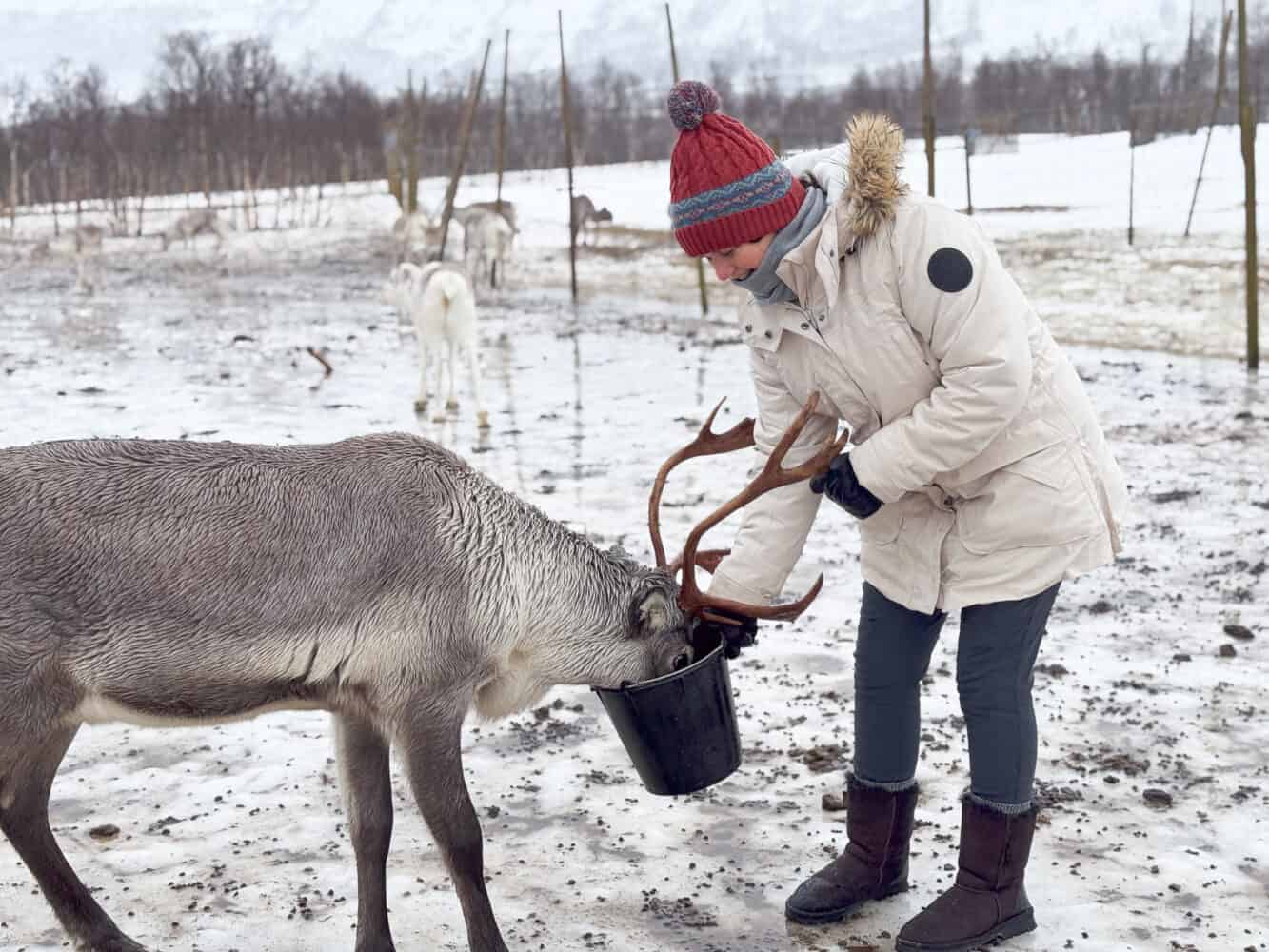
Spikes
Our Kahtoola Microspikes were essential! We bought them for our Southwest USA winter road trip and they were even more useful in Norway.
You pull these spikes onto the bottom of your shoes, providing excellent grip when walking on ice, even down hills.
They were especially useful on Kvaloya Island, where even walking through our village, Ersfjordbotn, was super icy. We wouldn’t have been able to do the coastal walk on Sommaroy without them.
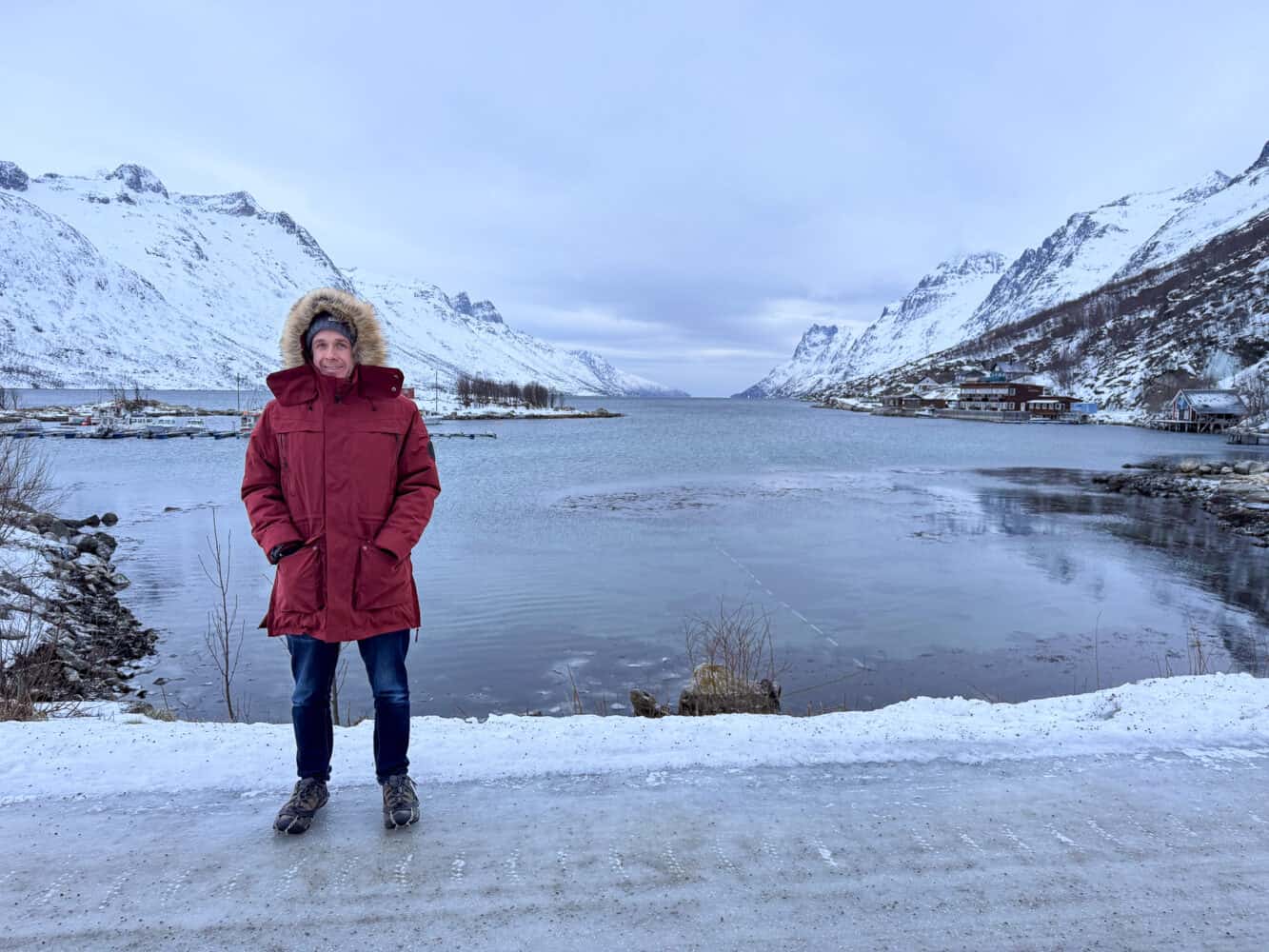
We didn’t need them in Tromso city centre, as the ice had been melted by the warmer temperatures and rain, but it is often icy there.
Shops and restaurants have signs asking you to take off your spikes before you enter (often with chairs where you can sit to do so). We used the bag they came in to store them, which fit in our jacket pocket when not used.
The microspikes we have are pretty hardcore and suitable for hiking. You can get little studded spikes (they sell them in many stores in Tromso), which would be fine for around town but not for much more.
What We Wore in Tromso in Winter
This was our typical outfit for various activities in Tromso in winter.
It worked for short walks, driving around Kvaloya and Sommaroy (with stops), cross-country skiing, reindeer feeding, and viewing the northern lights.
- Thermal bottoms (long johns)
- Thermal long-sleeve top
- Wool jumper
- Trousers or Jeans
- Parka
- Two pairs of merino socks (thin and thick)
- Winter boots (Erin) or hiking shoes (Simon)
- Hat, gloves, scarf/neck warmer
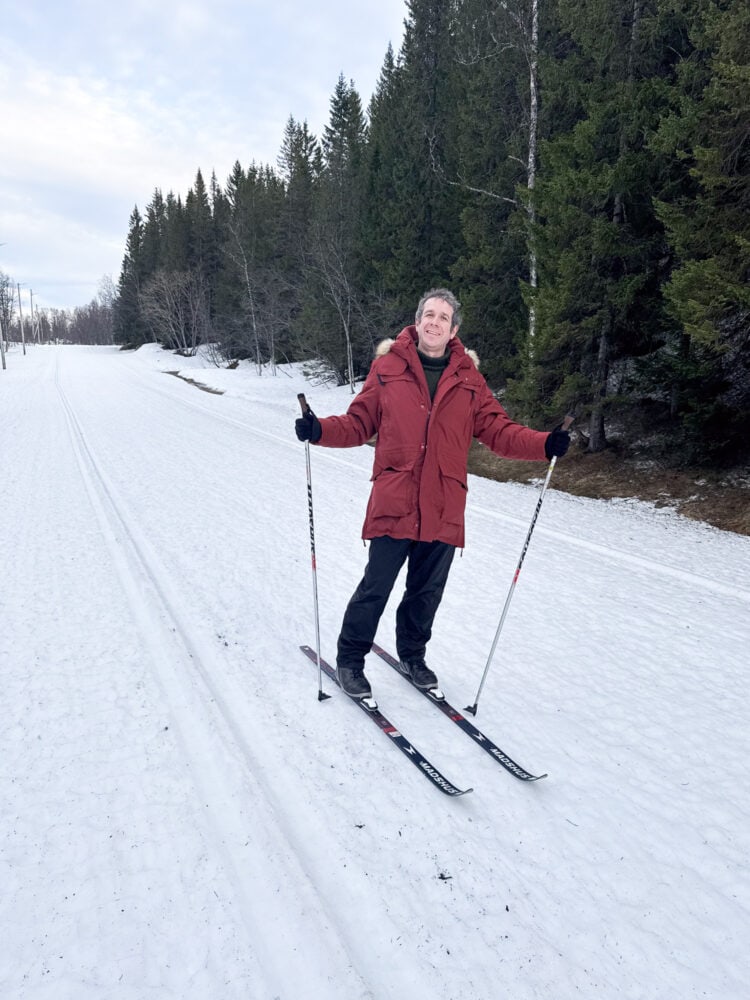
When going out for a quick dinner in Tromso, we often didn’t wear thermal bottoms, but our legs felt it if we walked around outside for too long.

If we hadn’t had such mild weather, we would likely have added an extra layer or two to stand around viewing the northern lights.
Dog Sledding
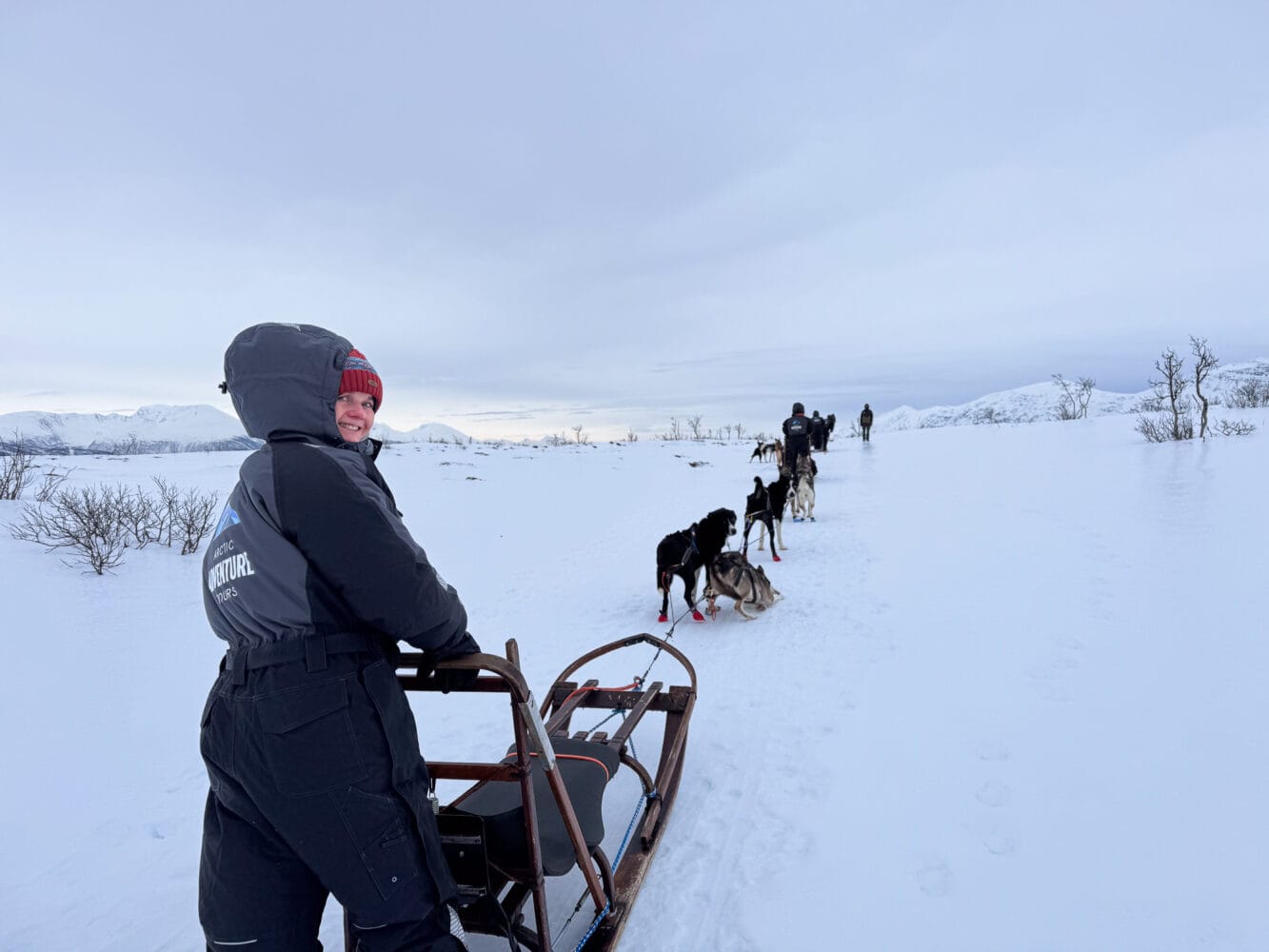
We went husky dog sledding on the coldest day. The centre provides a snow suit and boots, but it was so cold they recommended leaving our parkas and standard layers on under the suit.
Simon did this, but I found it too bulky so swapped my parka for a thick fleece jacket over my normal layers.
We were warm enough with this, but I felt it most in my hands and feet, so warm gloves and double socks are a must.
In Our Hotel
It’s usually warm inside buildings in Norway in winter. I was fine just taking off my jacket.
Our hotel in Tromso, Clarion Hotel The Edge was especially hot inside. We often went to breakfast in only one layer, and it was t-shirt weather in our room (even at the minimum temperature).
Our Norway Winter Packing List
This was our Norway packing list for a nine-day winter trip to Tromso (and Stockholm).
Luggage
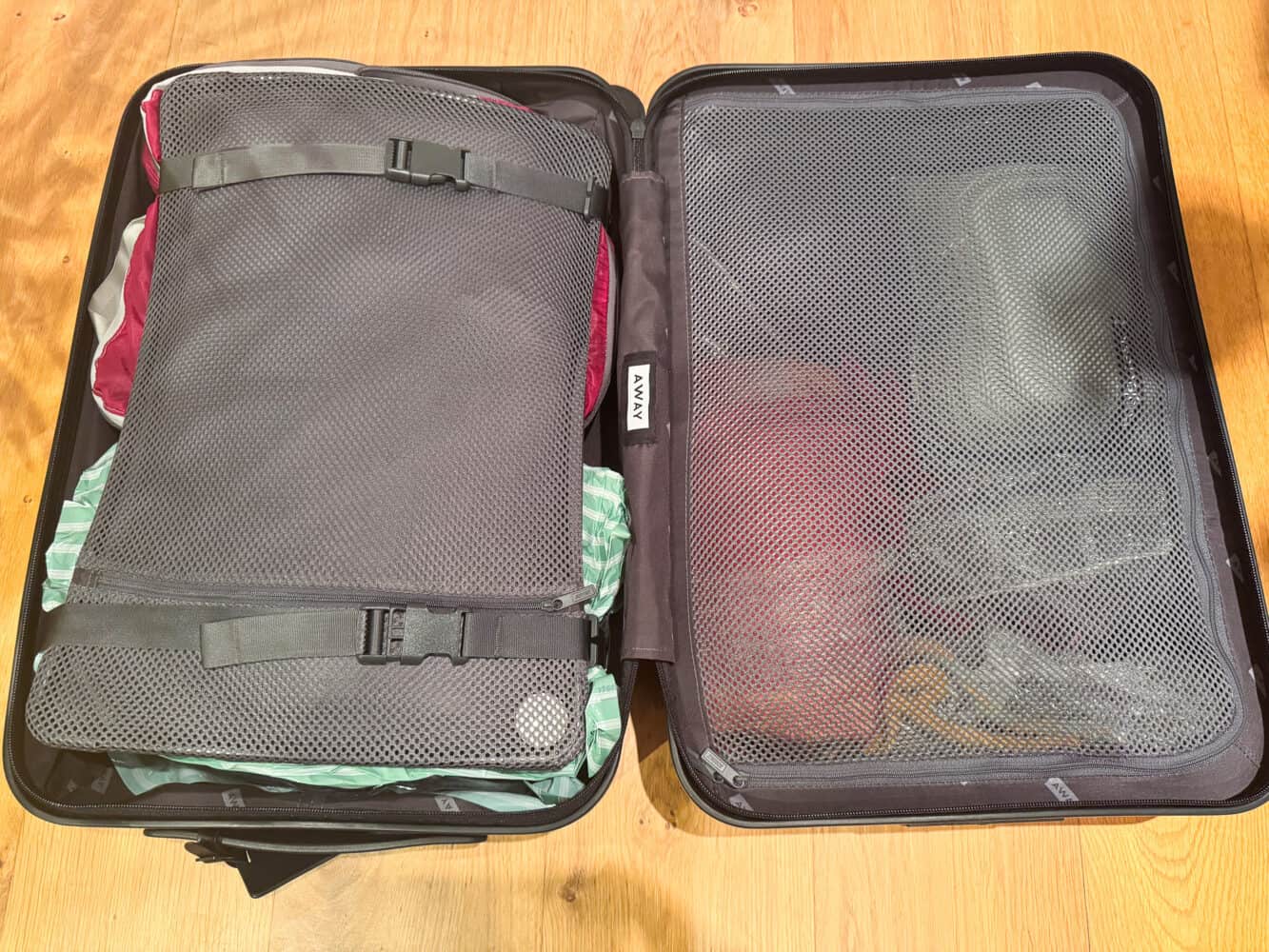
We technically travelled with just carry on luggage, but we chose to check our suitcases (included in our Norwegian Air package) to make getting on the plane stress-free (and yes, that’s a big change for us!).
- Away Bigger Carry On Suitcases x 2 – We absolutely love these and they are still going strong after six years.
- Tortuga Setout Laptop Bag (Simon) – Simon’s personal item on the plane. Sadly this backpack is no longer available. We love that is has a sleeve to slide over the suitcase.
- Matador Beast 18 Daypack (Erin) – My personal item is a hiking-friendly but lightweight backpack that we used for days out in Norway.
- Packing Cubes – Essential for organising our clothes and fitting more in. I took one medium and two small cubes from Eagle Creek, and Simon has Peak Design small and medium cubes.
- Packmate Travel Roll Storage Bag – I also had a vacuum type bag for my jumpers. You roll it up and it sucks out all the air and saves a lot of space for bulky items.
Erin’s Clothes
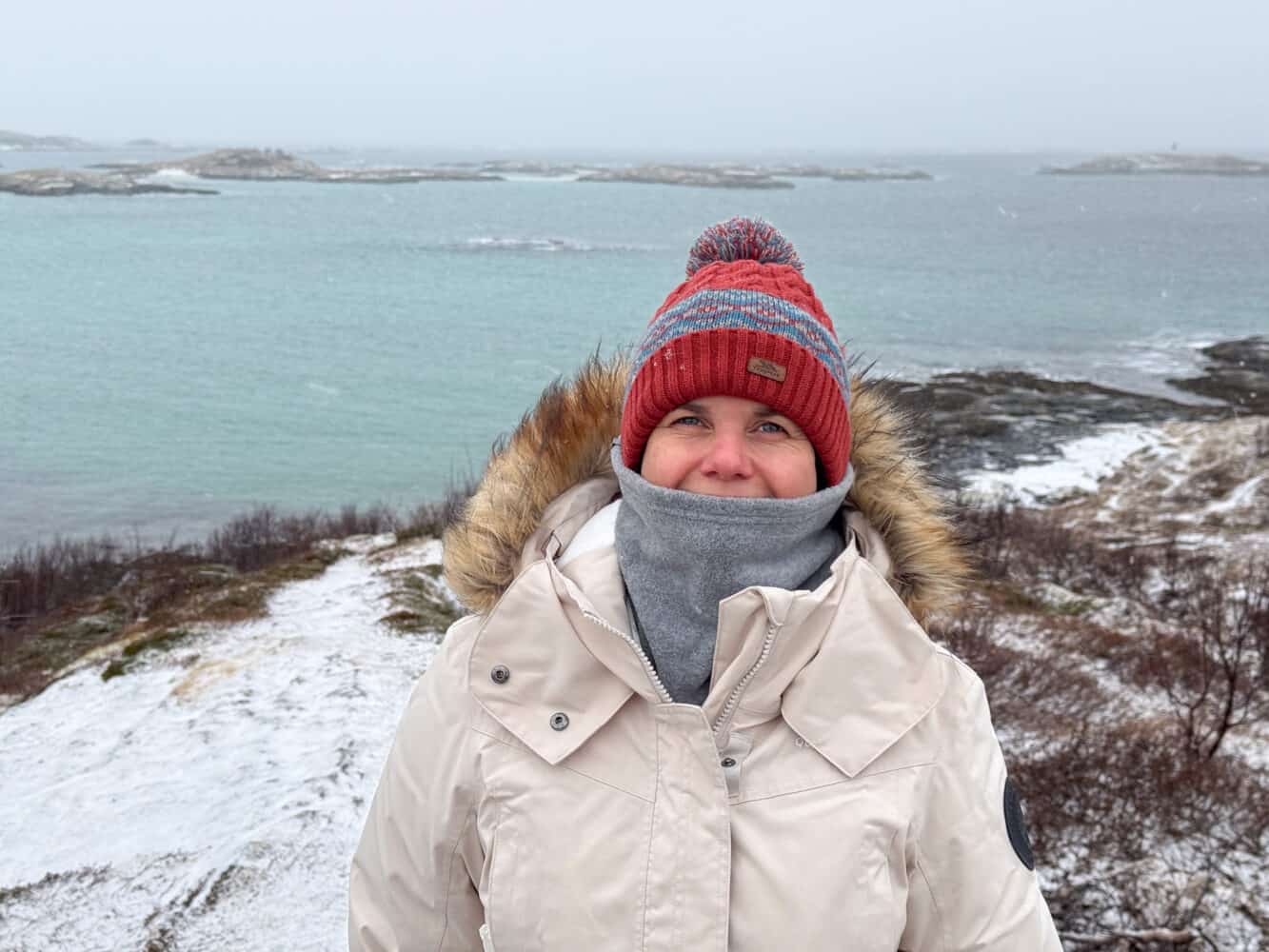
My Norway packing list includes what I wore on the plane.
Outerwear
- Decathlon Waterproof Hiking Parka -20°c
- Celtic & Co Aqualamb Boots
- Microspikes – You attach these to your shoes for walking on icy paths.
Bottoms
- Acai Skinny Outdoor Jeans – I mostly wore these on flights and in the evenings.
- Acai Thermal Skinny Outdoor Trousers – I wore these for active stuff.
- Mountain Warehouse 70% Merino Baselayer Bottoms – I wore these most of the time underneath.
- Lululemon Align Leggings – Regular leggings as a backup baselayer and to wear inside.
Tops
- Icebreaker Merino 200 Oasis Long-Sleeve Thermal Top x 2 – My favourite base layer for activities and when it was especially cold.
- Uniqlo Heatech Long-Sleeve T-Shirts x 3 – These aren’t as temperature-moderating and odour-resistant as merino, but they are cheaper. I have a few different ones but Ultra Warm is the warmest. I wore them more in the evenings.
- Wool Jumpers x 2 – I have 100% wool jumpers from Celtic & Co and Finisterre.
- Cashmere Jumper – This lighter jumper was for an extra layer under my thicker wool jumpers, but I only wore it a few times.
- Uniqlo Fluffy Fleece Jacket – Again, this would have been an extra layer on top of my jumpers but I only wore it once (for husky sledding).
Other
- Thick Merino Socks x 3 – I love the super warm Icebreaker Merino Mountaineer Mid Calf Socks.
- Thin Merino Socks x 4 – I have some thinner merino socks, like the Icebreaker Merino Hike+ Light Mini Socks, that I usually wore under the thick ones.
- Bras x 3 (including a sports bra)
- Underwear x 10
- Pyjamas
- Swimsuit – For the sauna/sea swim.
- Beanie Hat
- Fleece Headband – Sometimes this was useful under the hat when very windy.
- Fleece Neck Warmer – A cheap one from Decathlon.
- Scarf – I had one large one but found the neck warmer more practical most of the time.
- Silk Liner Gloves – Another Decathlon buy with touchscreen sensitivity for photos. I wore these under thicker gloves.
- Warm Gloves x 2 – One pair were thick waterproof ski gloves and the other were fleece lined. The second pair was nice to have but not necessary.
What I Packed But Didn’t Wear
- Hiking Shoes – My boots worked for all our activities.
- Lululemon Fleece-Lined Leggings – Not warm enough to wear on their own and a bit tight to fit thermals under.
- Tank Top – I didn’t need the extra layer.
- Spare Hat – I brought this in case the other one got wet, but as I used my hood in the rain, I didn’t need it.
- Sunglasses – It was cloudy all week.
Simon’s Clothes
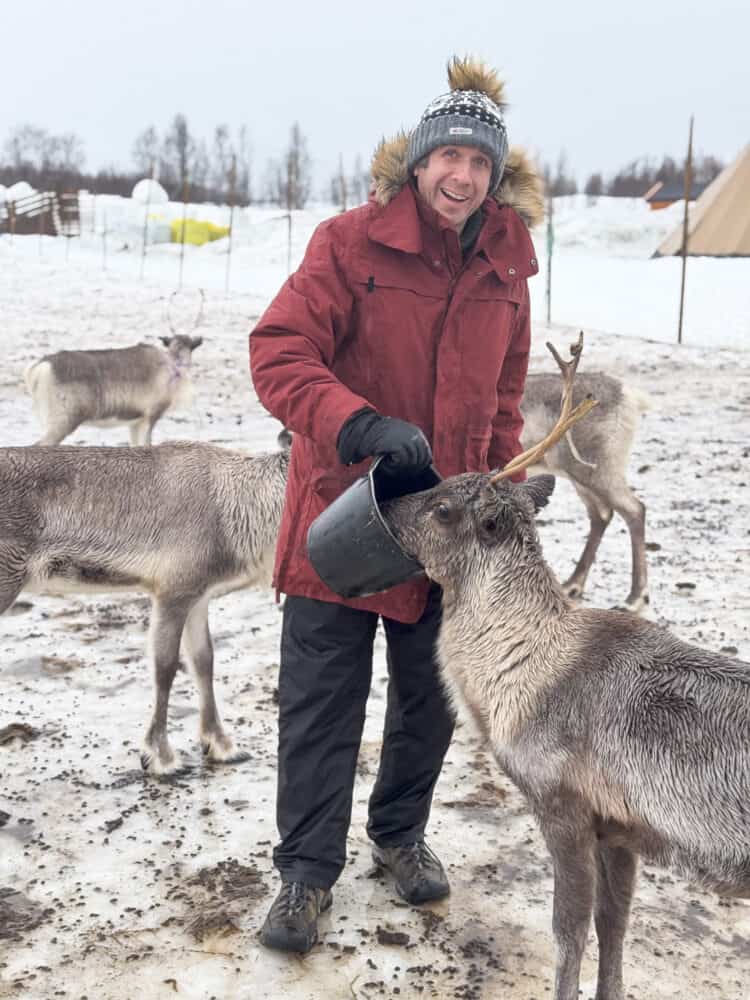
This is Simon’s men’s Tromso winter packing list. Again, it includes what he wore on the plane.
Outerwear
- Decathlon Waterproof Hiking Parka -20°c
- Keen Targhee Hiking Shoes
- Microspikes – You attach these to your shoes for walking on ice.
Bottoms
- Bluffworks Jeans – He mostly wore these on flights and in the evenings.
- Bluffworks Chinos – He wore these for more active stuff.
- Uniqlo Heatech Ultra Warm Tights – His base layer for under trousers.
- Waterproof Trousers – He wore these over the chinos for waterproofing and extra warmth.
Tops
- Thermal Baselayer Tops x 3 – He has one Icebreaker merino 260 top (the best but pricey), a Uniqlo Ultra Warm, and a 70% merino top from Mountain Warehouse.
- Bluffworks T-shirts x 3 – He wore them under the base layers or instead of when it wasn’t too cold (and in hot hotels).
- Roll Neck Merino Wool Jumpers x 2 – He has two Modern Submariners from Paul James that he loves as they are very warm and soft.
Other
- Thick Merino Socks x 3 including the Smartwool Mountaineer Maximum Cushion.
- Thin Merino Socks x 4 including Darn Tough Micro Crew Lightweight Hiking Socks.
- Underwear x 10
- Pyjamas
- Swim shorts – For the sauna/sea swim.
- Beanie hat
- Fleece Neck Warmer – A cheap one from Decathlon.
- Smartwool Merino Wool Liner Gloves – With touchscreen sensitivity. These were warm enough for around town and short walks.
- Waterproof Ski Gloves – These were warmer and more practical for activities like husky sledding and skiing.
What Simon Packed But Didn’t Wear
- Sunglasses
- Spare hat
Other Useful Items to Pack for Norway
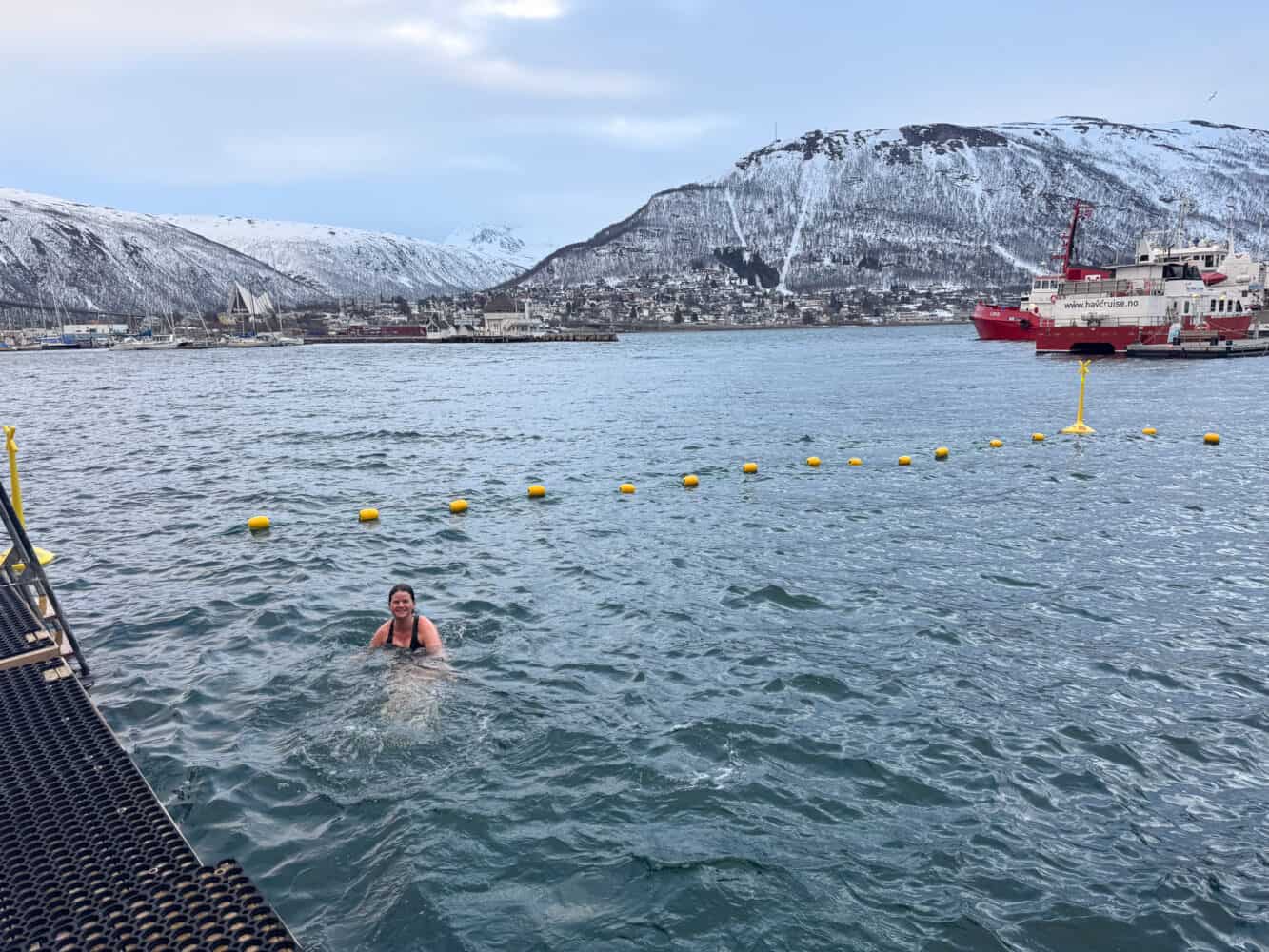
- Tripod – Essential for northern lights photography as you’ll need super slow shutter speeds (around 10 seconds). We got this cheap Amazon Basics tripod and it worked (although we did hold down the legs in the wind).
- Universal Travel Power Adapter – We use one similar to this one from Tessan with USB sockets so we can charge multiple devices at once. Norway uses the European-style two-round pin plugs.
- Travel Towels x 2 – We used these for the sauna. Look for something quick-drying and compact like the PackTowl.
- Moisturiser and Lip Balm – Norway is very dry in winter.
- Lush Solid Shampoo Bar – If you are staying in self-catering accommodation, shampoo and shower gel might not be provided so we used this for both.
- Fee-Free Debit and Credit Cards – We didn’t need any cash in Norway (or Sweden) and paid with contactless everywhere. For Brits we recommend a Starling debit card and Halifax Clarity Credit Card.
- Travel Insurance – Essential for any trip. We have a True Traveller (UK/EU only) annual policy and have always found them reliable.
Food and Drink
Most of these won’t be relevant to you unless you are self-catering or really into coffee like Simon.
- Water Bottles x 2 – We like the Klean Kanteen 800ml bottles.
- Reusable Coffee Cup
- AeroPress Go Travel Coffee Maker – Simon likes to make his own coffee (even at the hotel buffet).
- Porlex Mini Coffee Grinder
- Coffee Beans
- Food – As we were self-catering for the first few days, we brought some things with us including oats and small amounts of cinnamon/nuts/raisins for oatmeal, and Merchant Gourmet Tomatoey Lentils (for an easy meal with baked potatoes).
- Herbal Tea Bags – I like to have a selection.
- Reusable Shopping Bags – For grocery shopping.
- Ziploc Bags and Beeswax Wraps – These were useful for storing snacks and making sandwiches for road trips.
We also packed our usual electronics (minus the laptops) and toiletries, which you can see in our carry on packing list.
What We Didn’t Use
We didn’t end up using these items:
- Camera – I took my Sony A7III. Unfortunately, I didn’t have a tool to connect the tripod to my camera so I couldn’t use it (Simon used his iPhone for aurora photography). I used my phone for most photos because the weather was so snowy/rainy.
- Head Lamp—If we had ended up in a more remote location for viewing the northern lights, this might have been useful when setting up the tripod. We had a half moon, which gave us enough light.
- Waterproof Phone Case – This was for kayaking and our trip was cancelled.
- Leg Gaiters – We brought these to wear over our hiking shoes in case of deep snow but didn’t need them.
- Battery Pack – We brought the one from the Away suitcase because we’d heard the cold can quickly diminish your phone’s power. We didn’t have an issue with this, although taking northern lights photos on Simon’s phone almost depleted the battery.
- Flask – This might have been useful for hot drinks on road trips but we didn’t bother.
More Norway Tips
Read more about Tromso and Northern Norway in winter with our other guides:
- 12 Unmissable Things to Do in Tromso in Winter (and What to Skip)
- Exploring Kvaloya and Sommaroy Islands Near Tromso
- Is Tromso Expensive? Our Northern Norway Trip Cost
- Visiting Tromso in February: Everything You Need to Know
If you enjoyed this post, pin it!
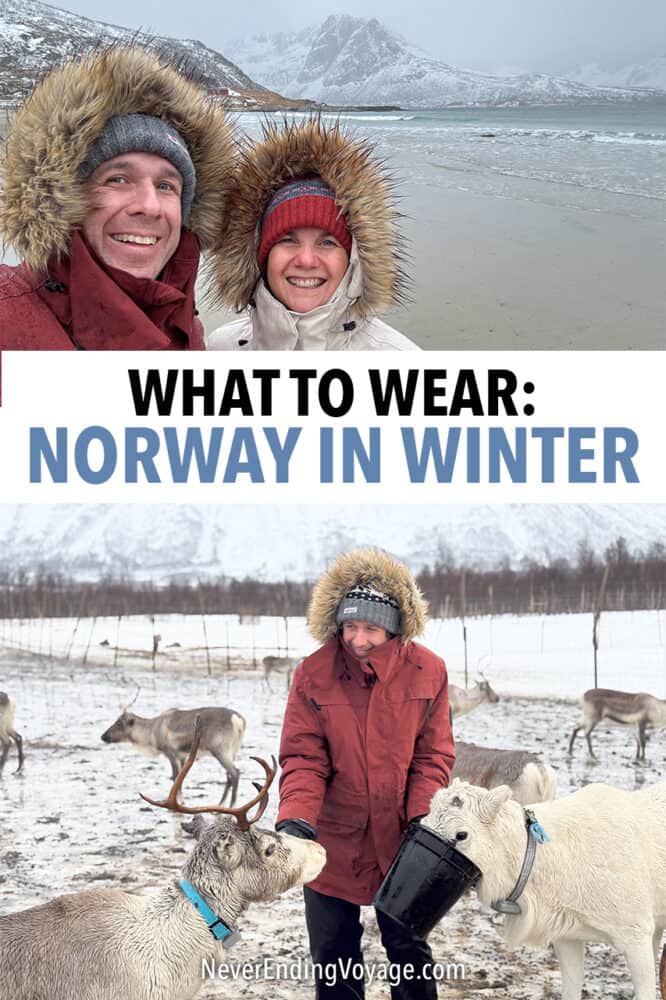
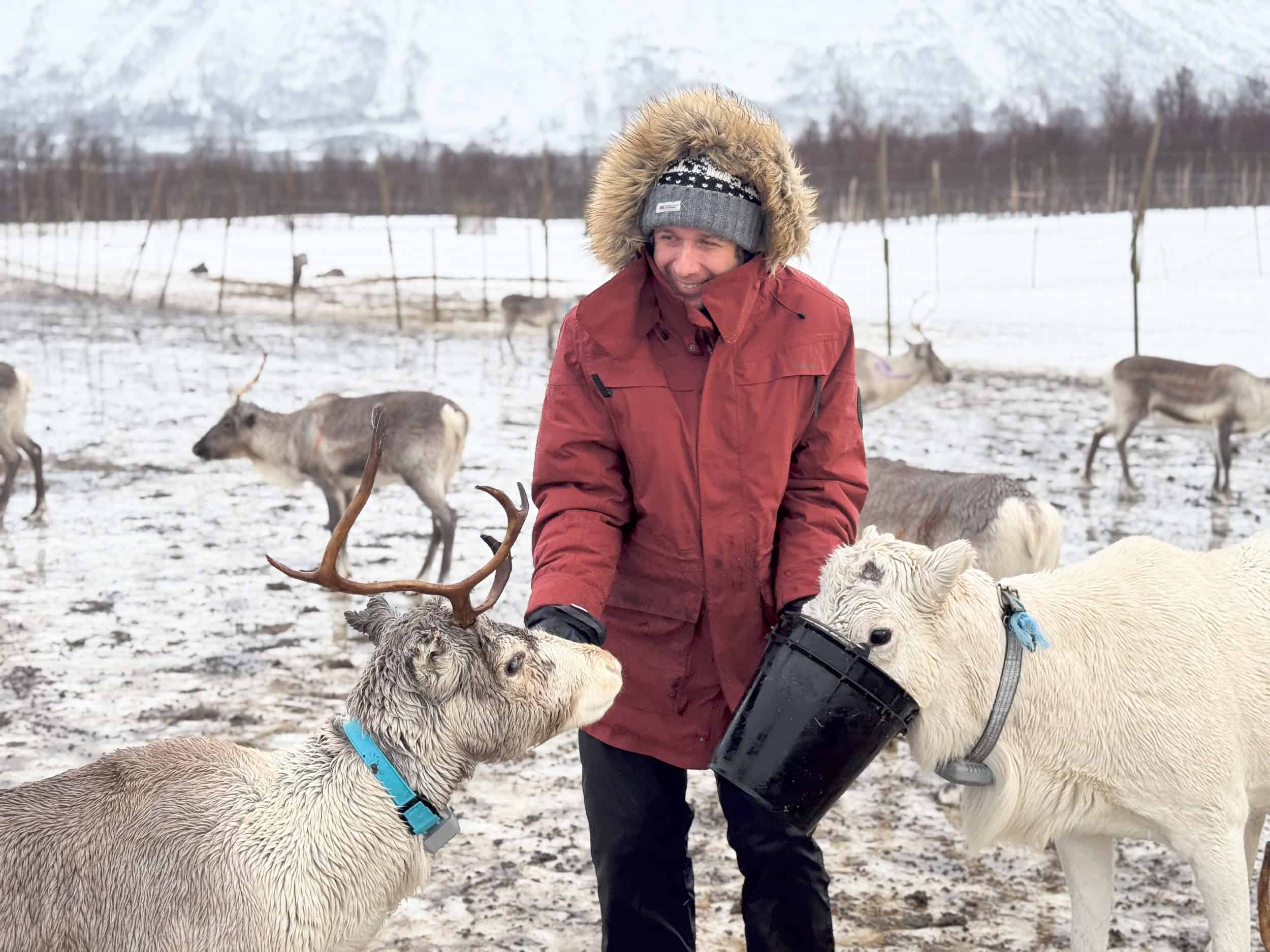
Very helpful packing tips on clothing and accessories that you don’t think of.
And general tips, all great reading.
From NZ going to Norway March 2026
Thank you